Name: Kathryn Kremnitzer, Siddhartha Shah
Date and Time:
2015.10.19
Location: Lab
Subject: Red Lake Pigments
We began preparing ingredients necessary for the recipe at 9:00am
Preparation:
- Weighed 1.5g of cochineal in small plastic cup before grinding
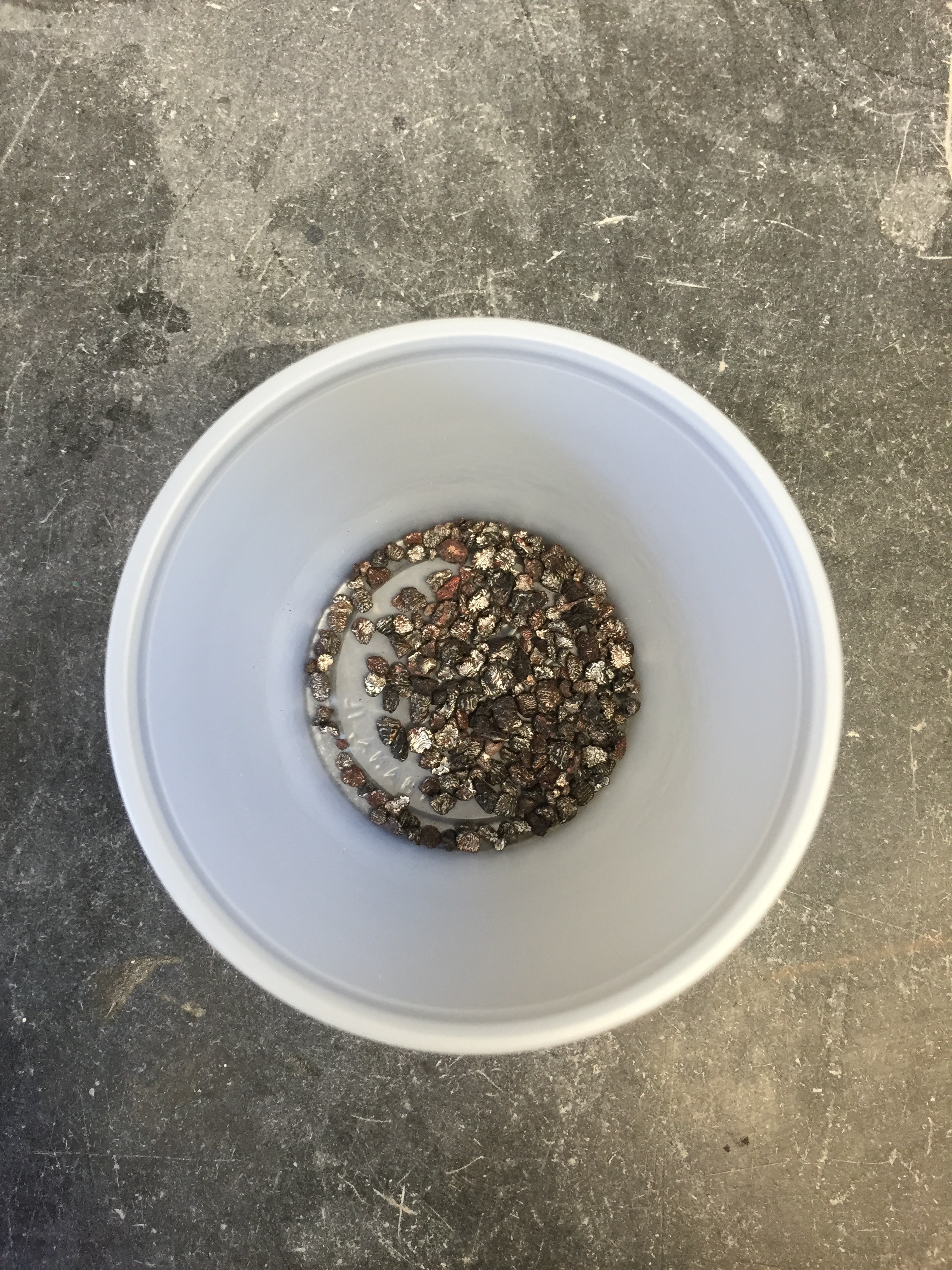
- Ground cochineal in small marble mortar with marble pestle
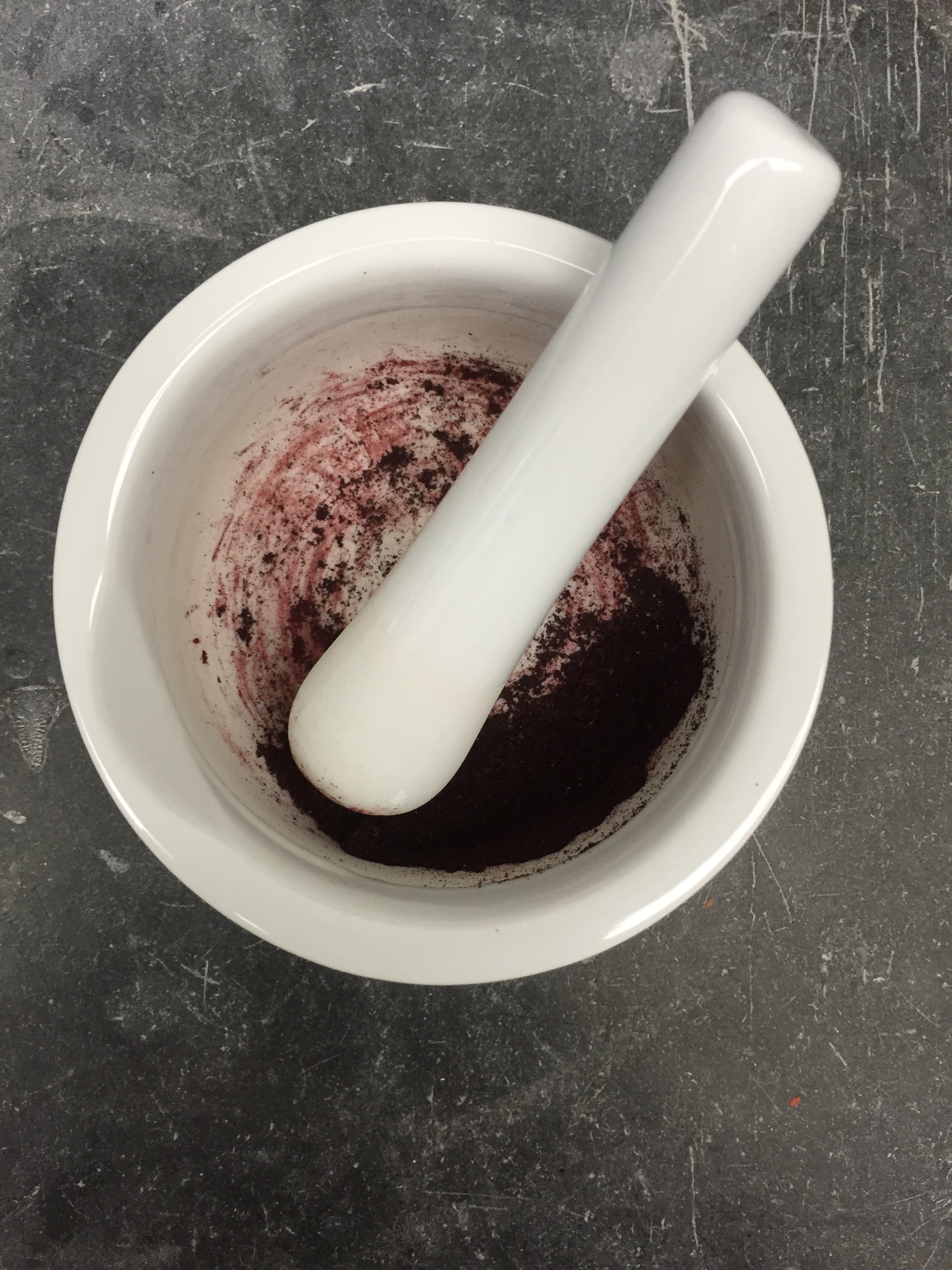
- Divided 1.5g of cochineal into six containers of 0.24g each
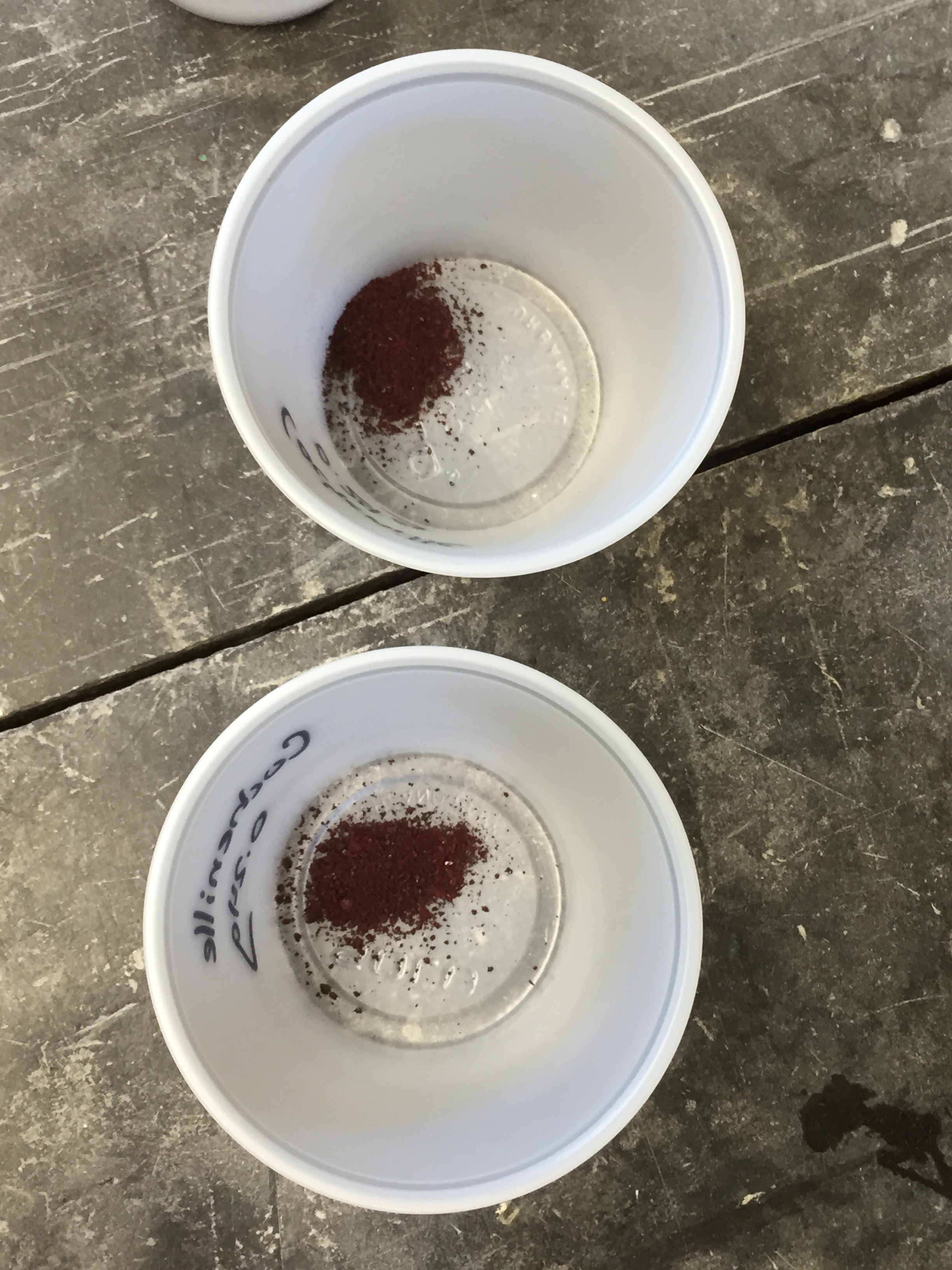
- Crushed four additional insects in fear of not having enough ground cochineal to fill 6 containers
- Weighed 10g of logwood in small plastic cup
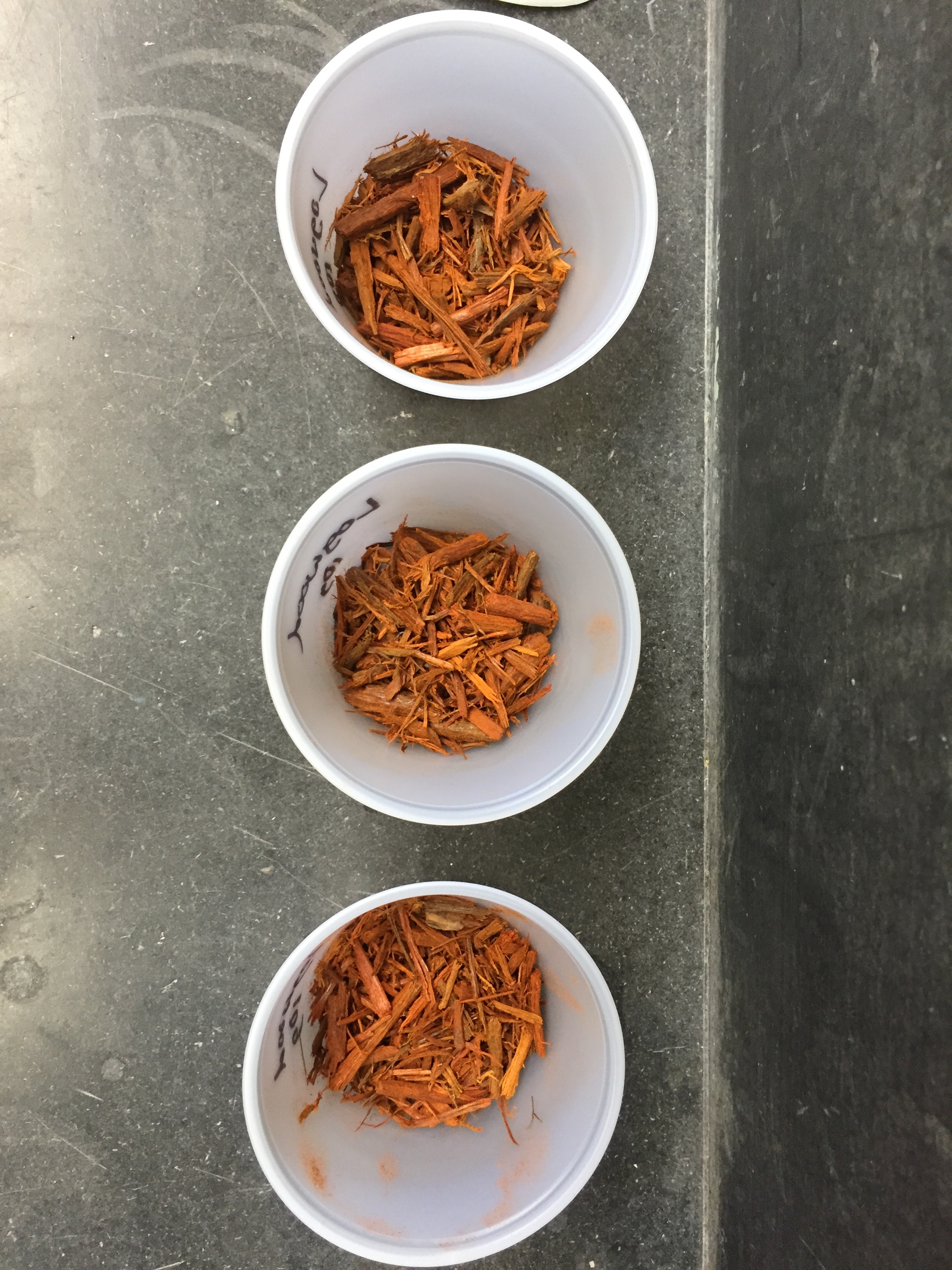
- Weighed 10g of brazilwood in small plastic cup
- Put logwood in double lined cheesecloth sachet, tied with twine
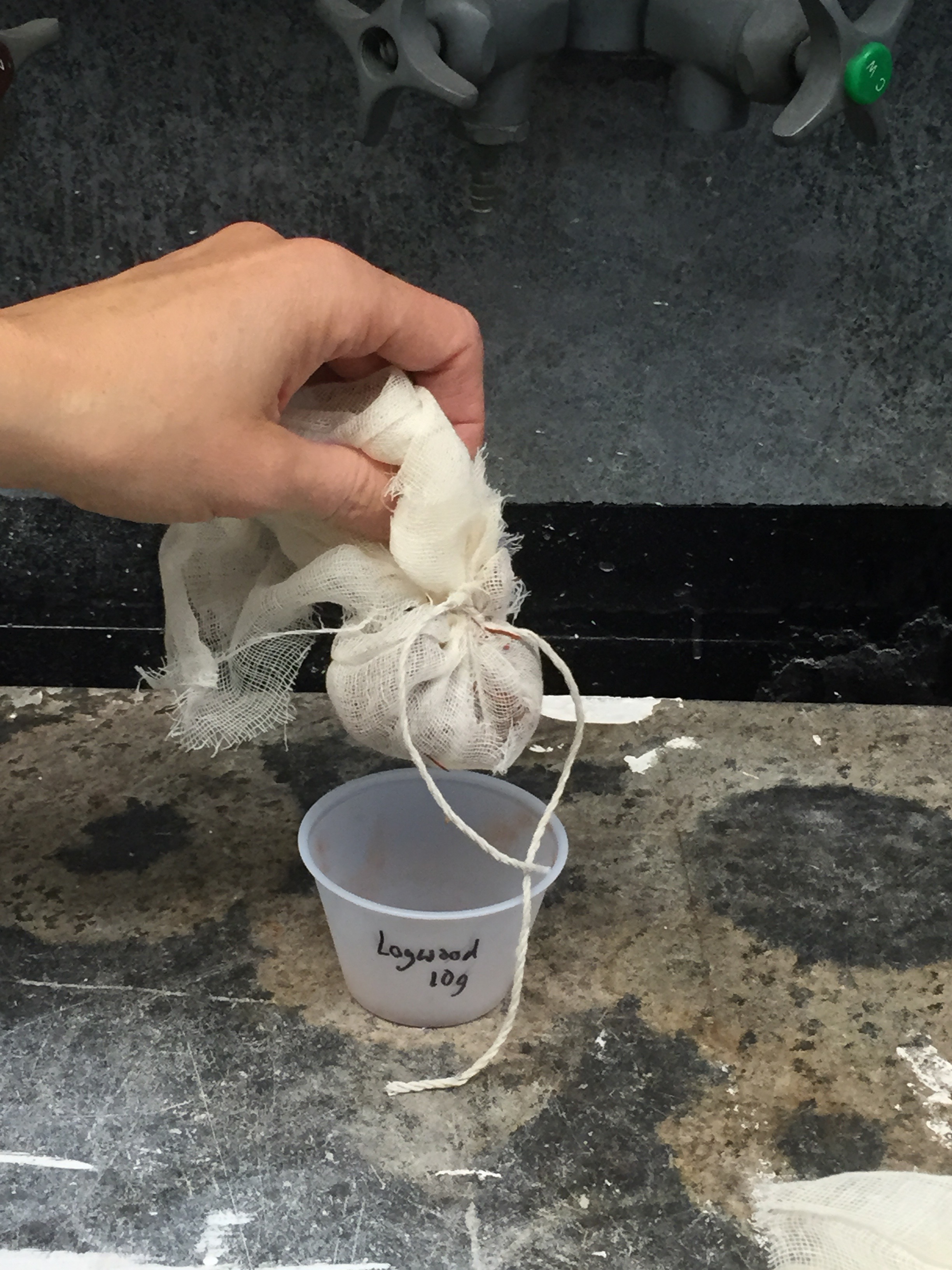
- Put brazil wood in quadruple lined cheesecloth sachet, tied with twine
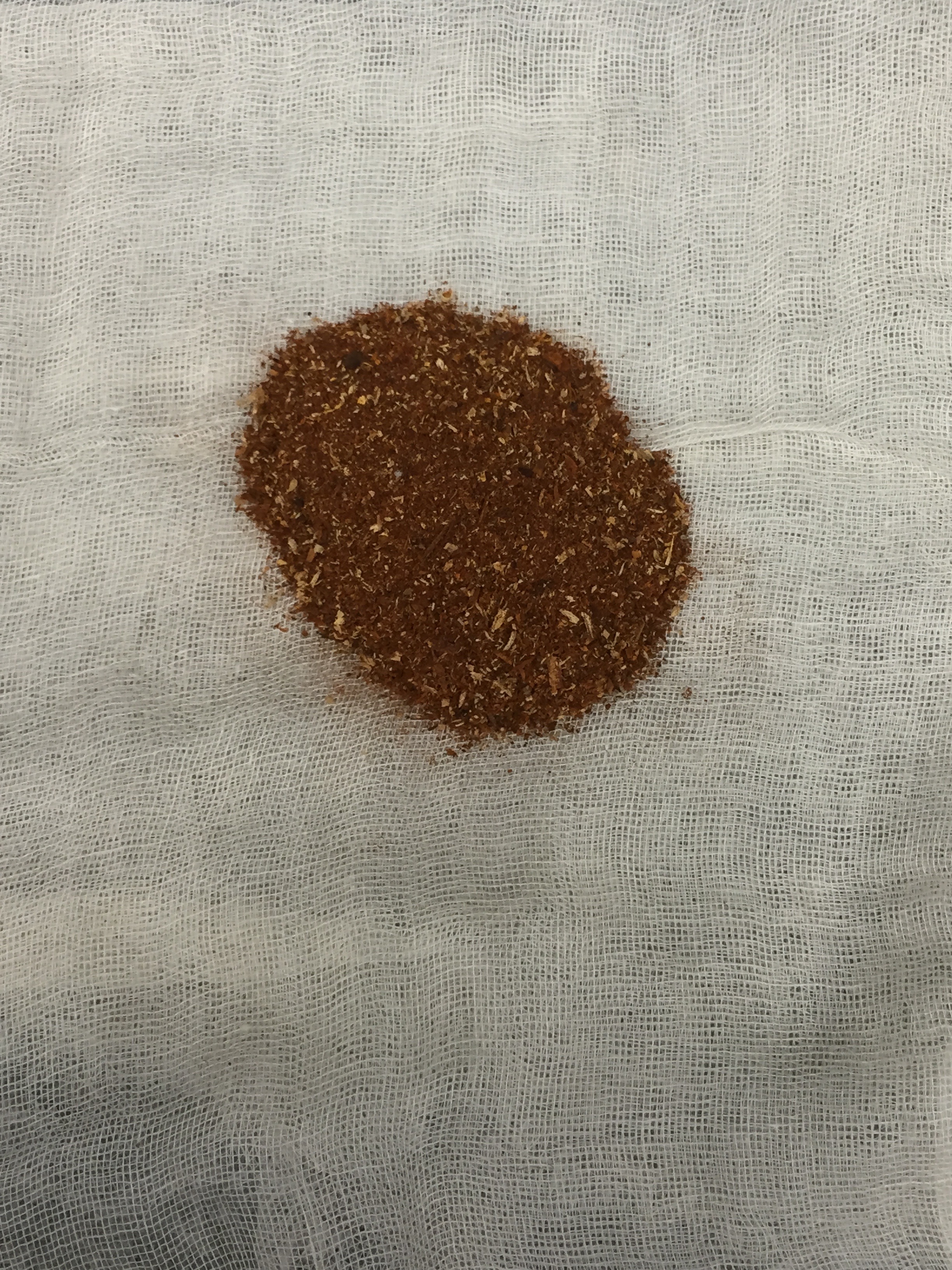
9:47am
Put two sachets of logwood in separate beakers of 200 ml of distilled water and potash and one sachet of logwood in a beaker of 200 ml of tap water and potash, used spoon initially to submerge logwood
9:47am
Put two sachets of brazilwood in separate beakers of 200 ml of distilled water and potash and one sachet of brazilwood 200 ml of tap water and potash, used spoon initially to submerge brazilwood
9:53am
Soaking logwood is significantly more blood red than rather aqueous looking than soaking brazilwood
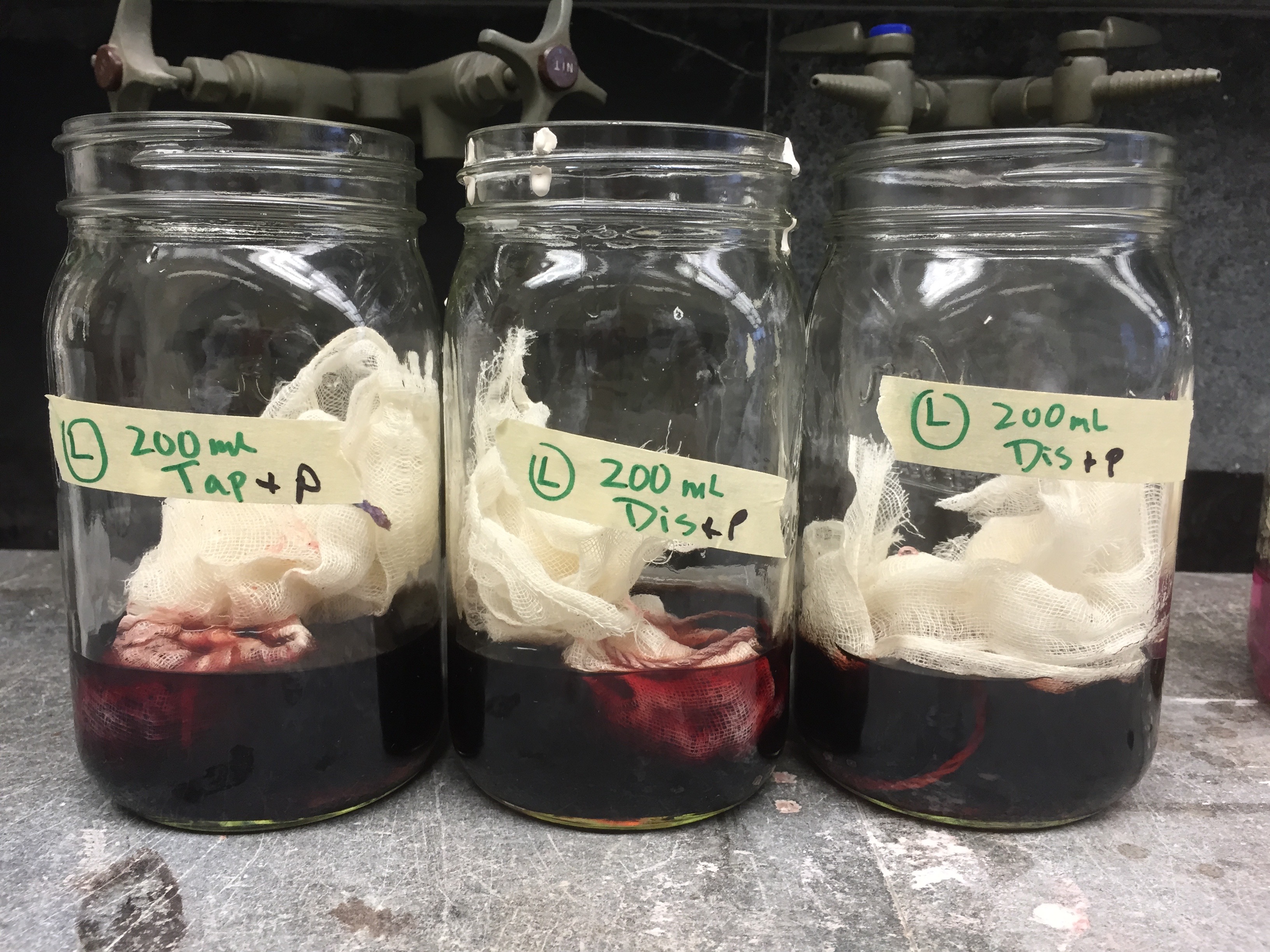
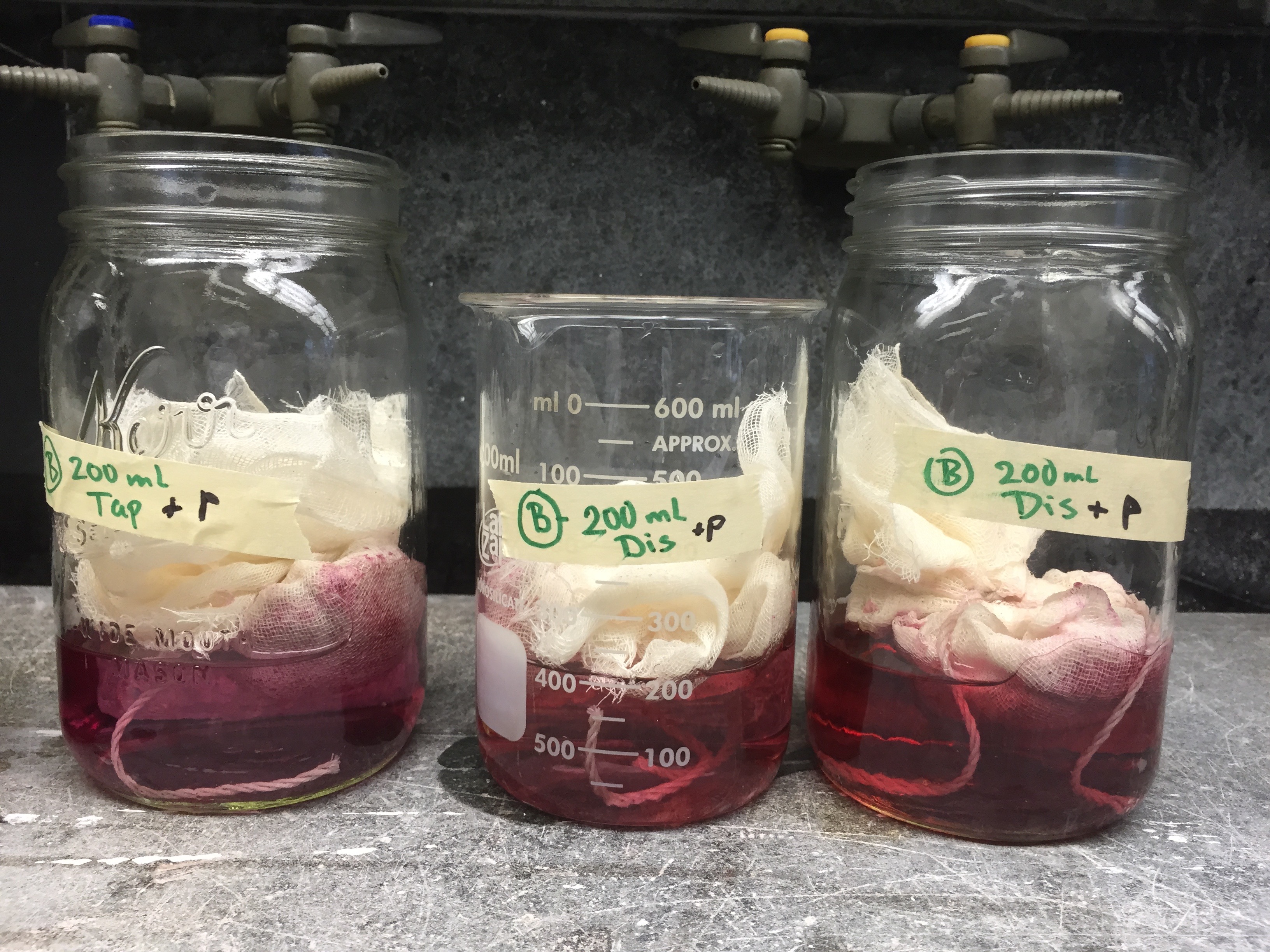
Setup of Stations:
CD: cochineal distilled
CT: cochineal tap
BD: brazilwood distilled
BT: brazilwood tap
LD: logwood distilled
LT: logwood tap
Station 1:
CD
BD
Station 2:
CD
BD
Station 3:
CD
BT
Station 4:
CD
LD
Station 5:
CD
LD
Station 6:
CT
LT
SS/KK – STATTION 2 (CD, BD)
9:47am
Soaking sachet of brazilwood in 200ml of distilled water and potash (need to soak for 2 hours)
10:18am
Put 0.24g of cochineal into large jar of 500ml distilled water and 300 ml of 0.1 M potassium carbonate (K2C03) solution [potash]
10:20am
Put jar on lid in water bath on hot plate set at 3
10:25am
Discussion about what to do and pros/cons of shared substance re: time it takes to boil but we didn't transfer anything
Turned burner up from 3 to 5 following PS instructions to get it to boil
10:26am
Combined Cindy and Yuan’s solution with SSKK solution (will have to re-separate the solutions into 300ml each)
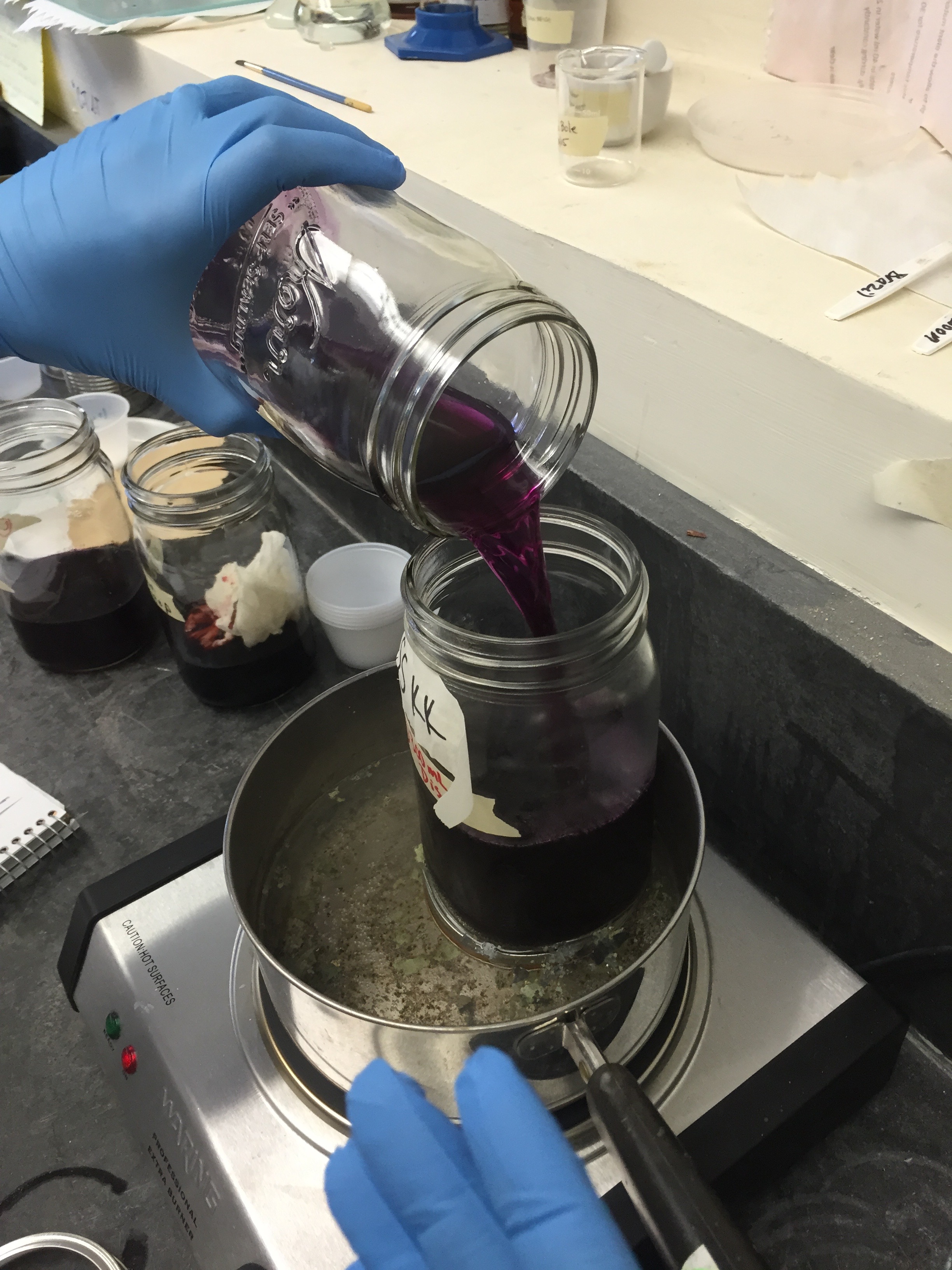
10:27am
Switched water bath water out (debris in previous pot) - starting over (re: boiling) although water is not cold
10:32am
Dissolving 10g of potash in 50 ml of distilled water WITHOUT heating for now
10:35am
Cochineal solution is 38 degrees Celsius
10:37am
Potash is not dissolving in distilled water without heat.
Dissolving 10g of potash in 50 ml of distilled water over heat suspended in water bath by wire system held with two fingers

10:41am
Cochineal solution is at 54 degrees Celsius
10:41am
Potash is almost dissolved in water
10:42am
Reduced heat to 3.5 (after a certain point at 5, the temperature seems to blast, so we decided to reduce)
10:43am
Potash is dissolved, we are setting solution aside
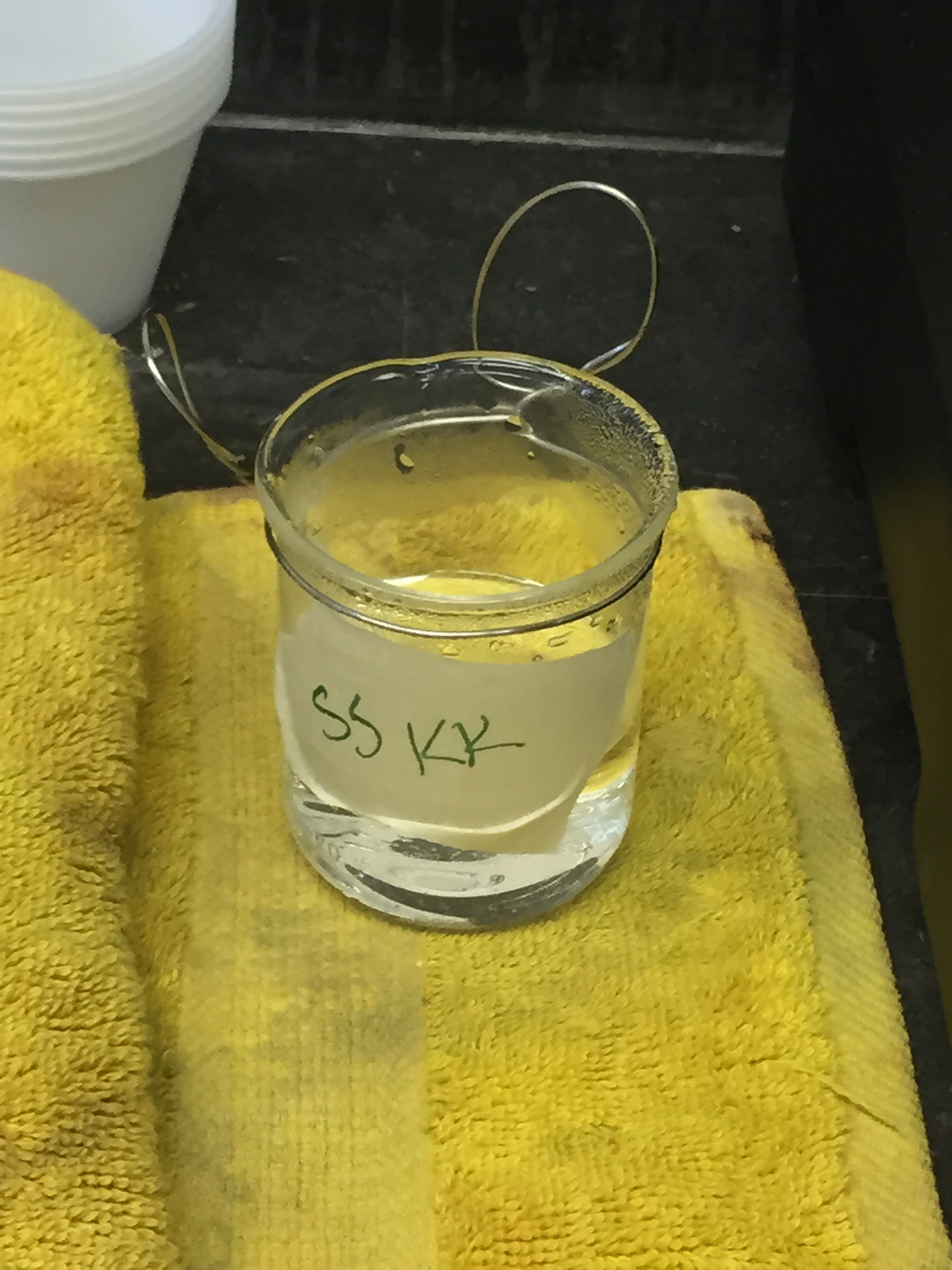
10:44am
Noticed solids forming on top of cochineal solution
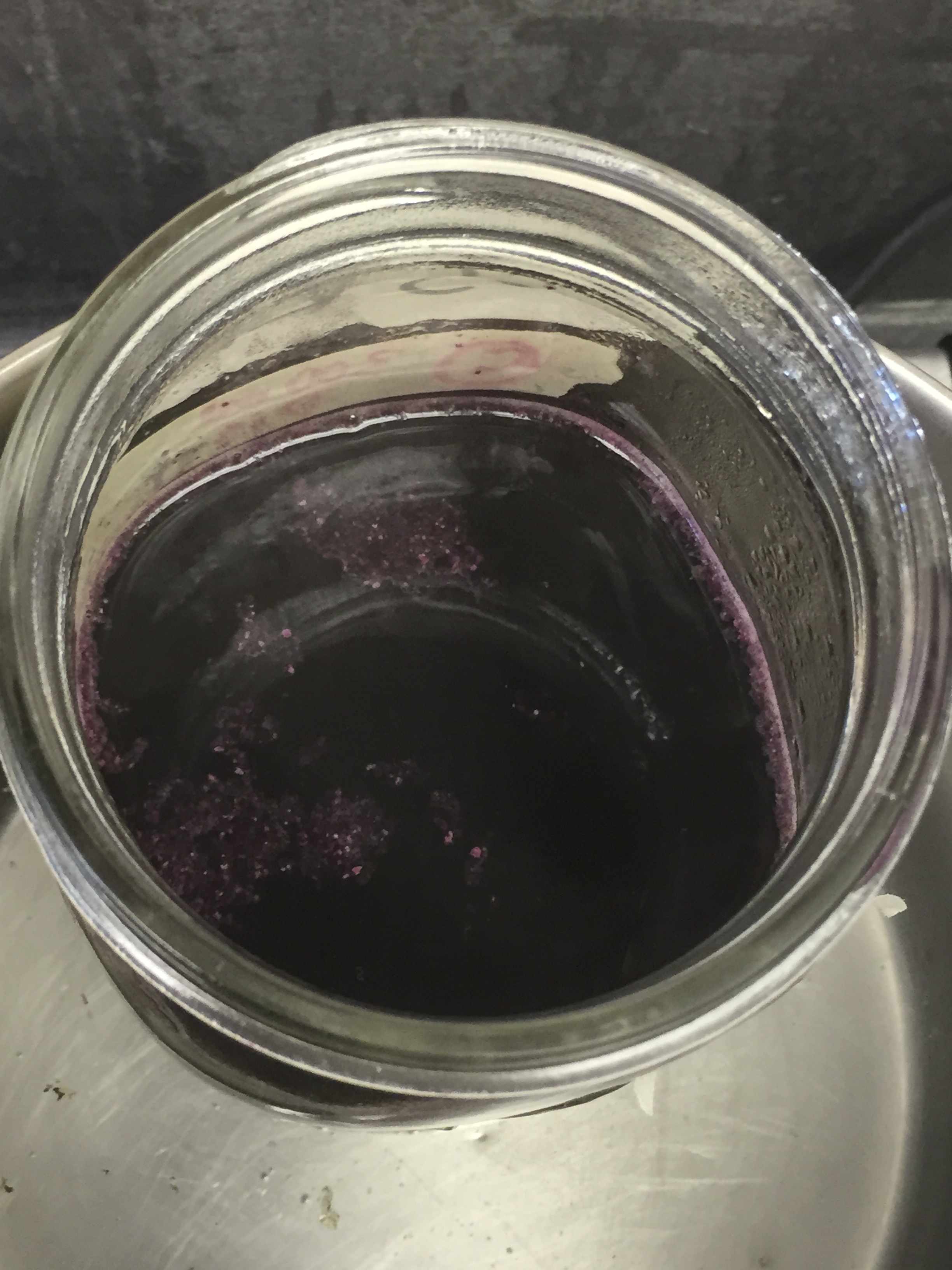
10:46am
Cochineal solution is at 65 degrees Celsius
10:53am
Water bath is boiling
10:54am
Cochineal is at 76 degrees Celsius and climbing
11:02am
Cochineal is at 80 degrees Celsius
11:04am
Turned heat up to 5
Concerned that cochineal solution may not boil in that heat is already turned all the way up
11:06am
Transferring cochineal solution to a beaker and removing from water bath to be directly on hot plate (having turned temperature off for a second) in the hopes of boiling
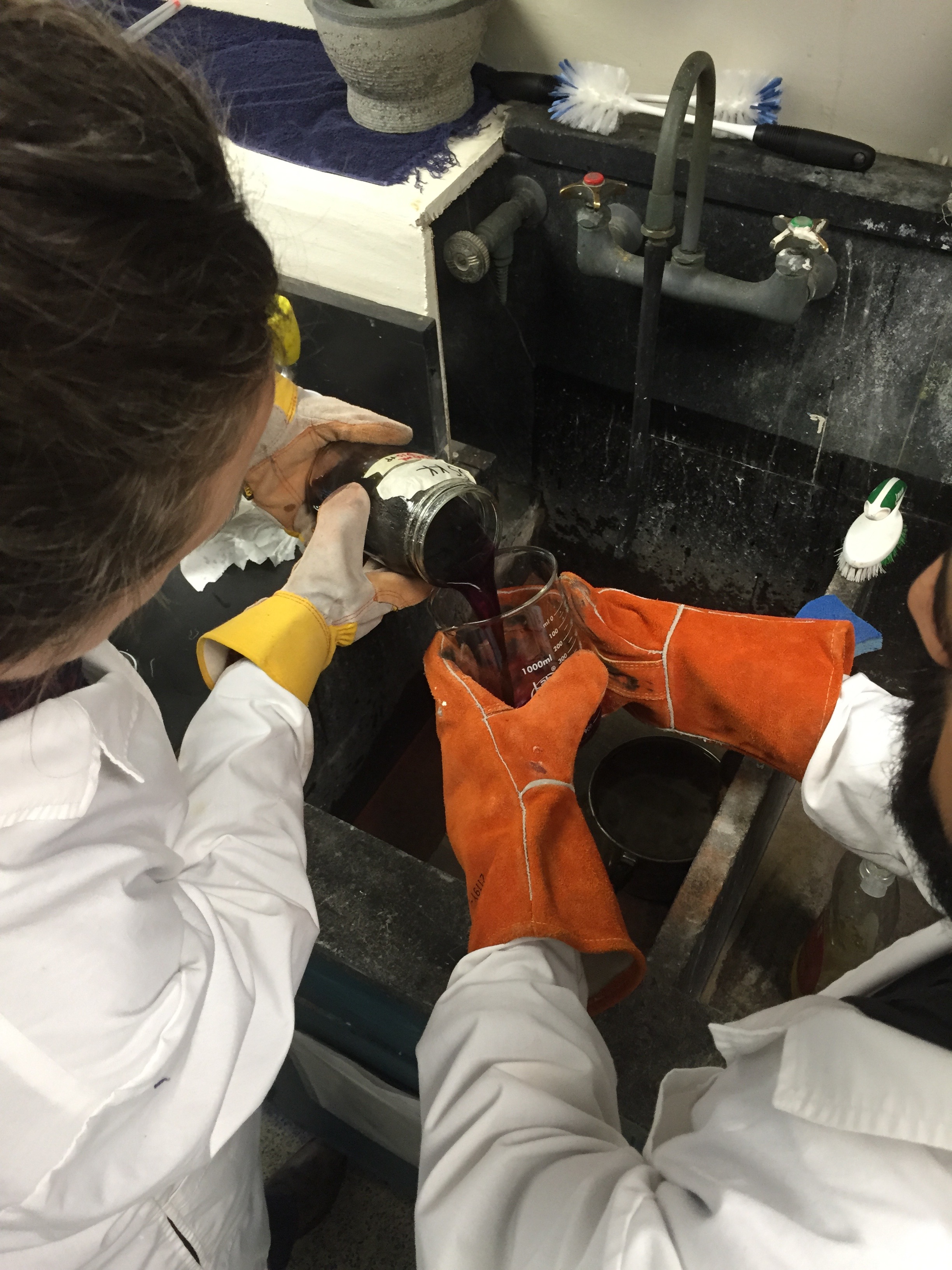
The solution has already cooked down a bit because we now have just over 500ml (combined original solution [SSKK + Cindy/ Yuan] was originally 600ml)
Put beaker on TURNED OFF hot plate
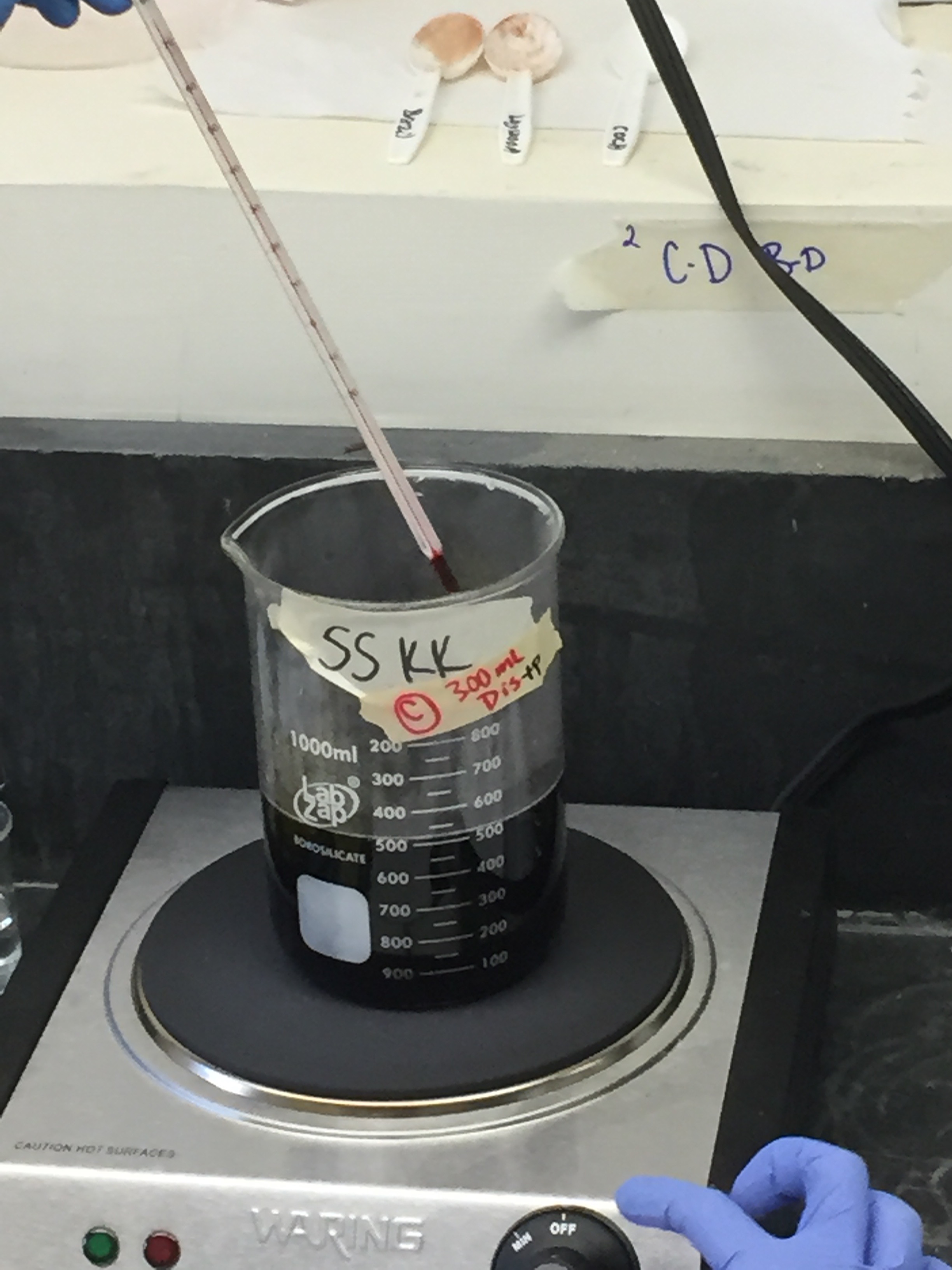
Plan to heat directly on hot plate for five minutes in the hopes of boiling
11:09am
Cochineal solution is 76 degrees Celsius with hot plate TURNED OFF
11:12am
Turned hot plate back on?
Cochineal solution is at 77 degrees Celsius
11:19am
Splitting solution into 250ml each in the hopes that two beakers with solution will boil faster than one large beaker
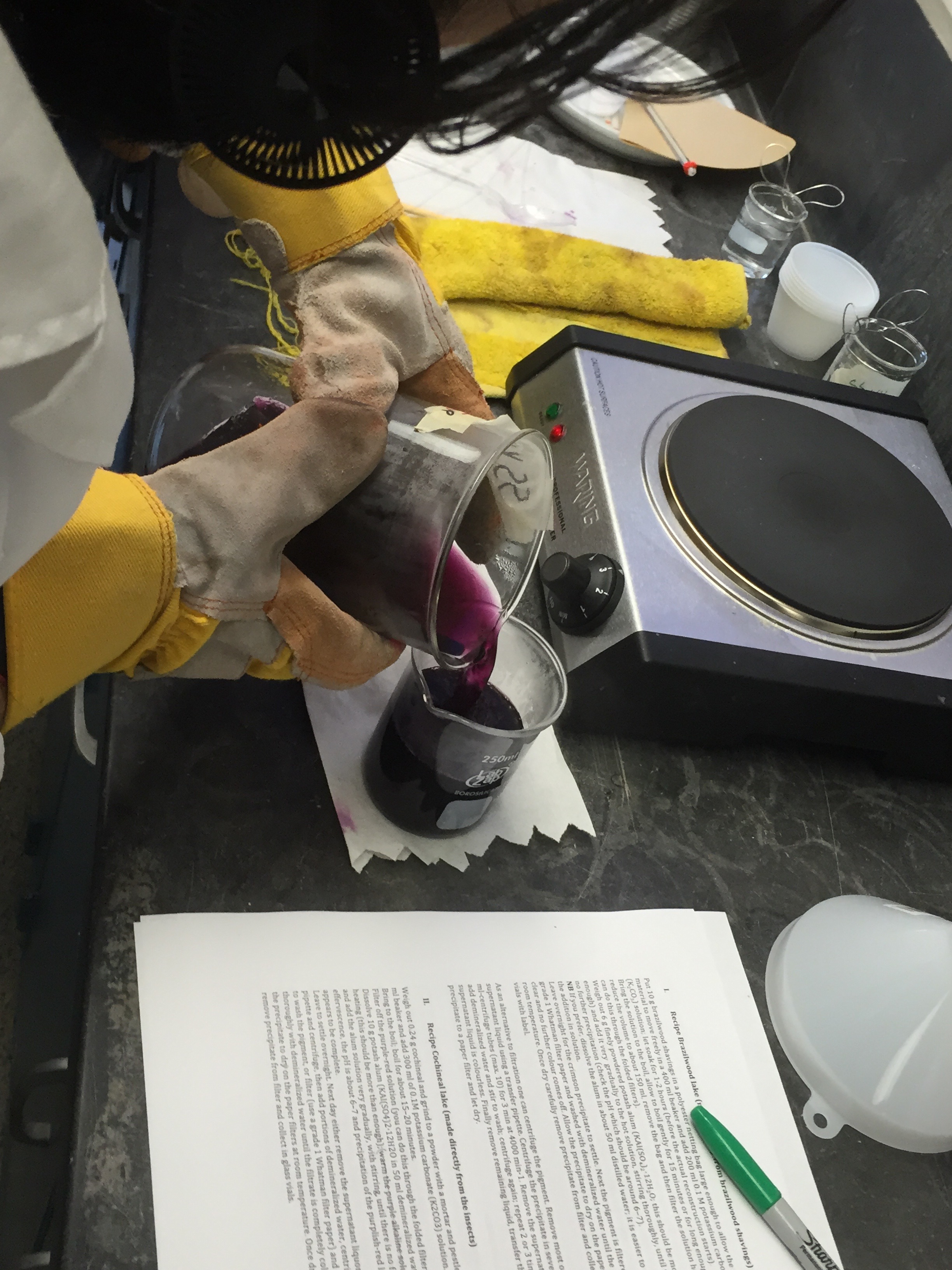
11:28am
Rolling boil of cochineal solution in larger beaker, smaller beaker is beginning to bubble
11:32am
Slowly filtering our (smaller beaker) solution
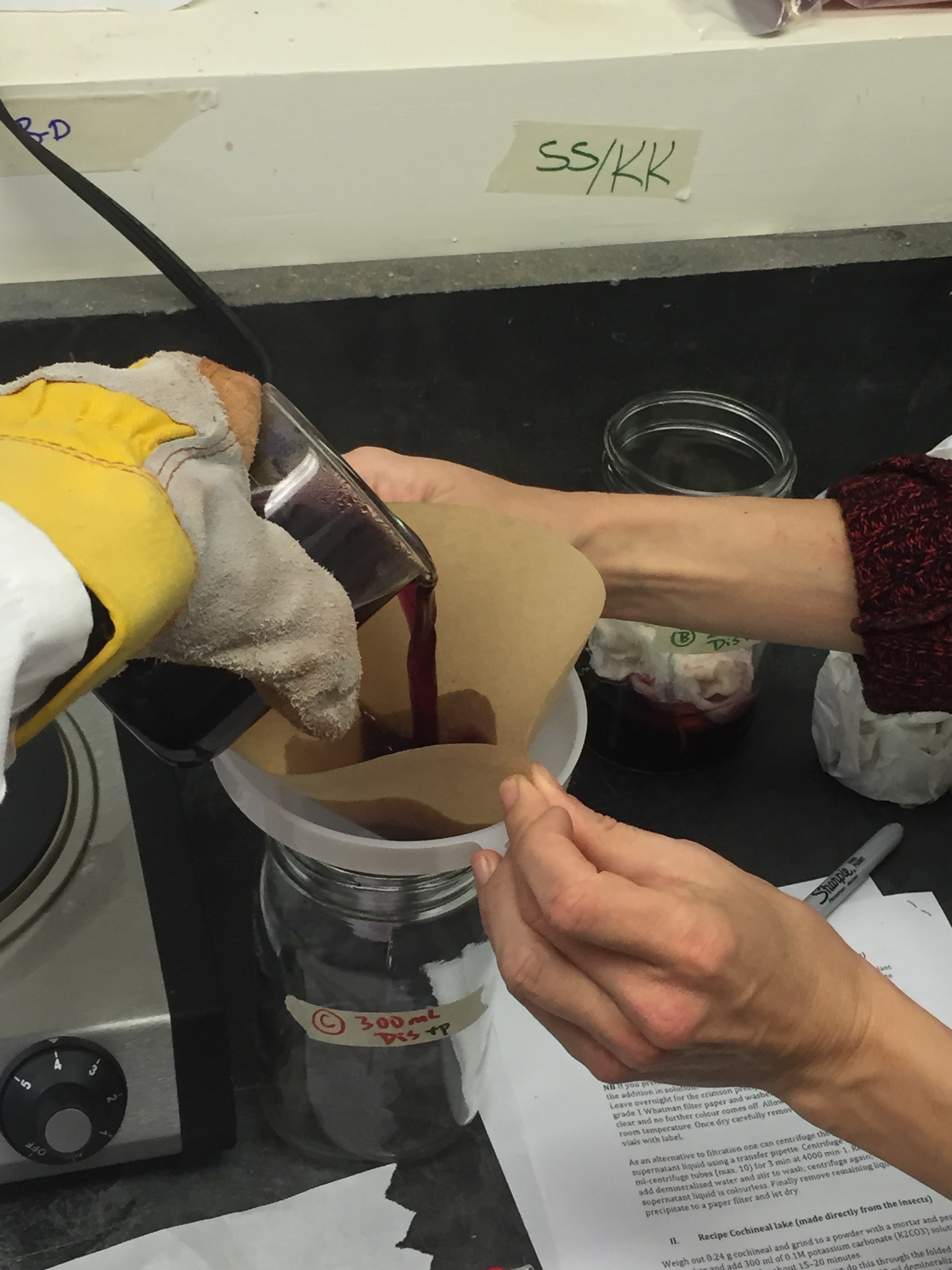

11:34am
Put potash back on heat for a bit to re-dissolve some particles that had formed or had not originally dissolved
11:35am
Cochineal is at 65 degrees Celsius
11:38am
Slowly poured in potash solution (drop by drop) to cochineal solution while stirring; achieved effervescence
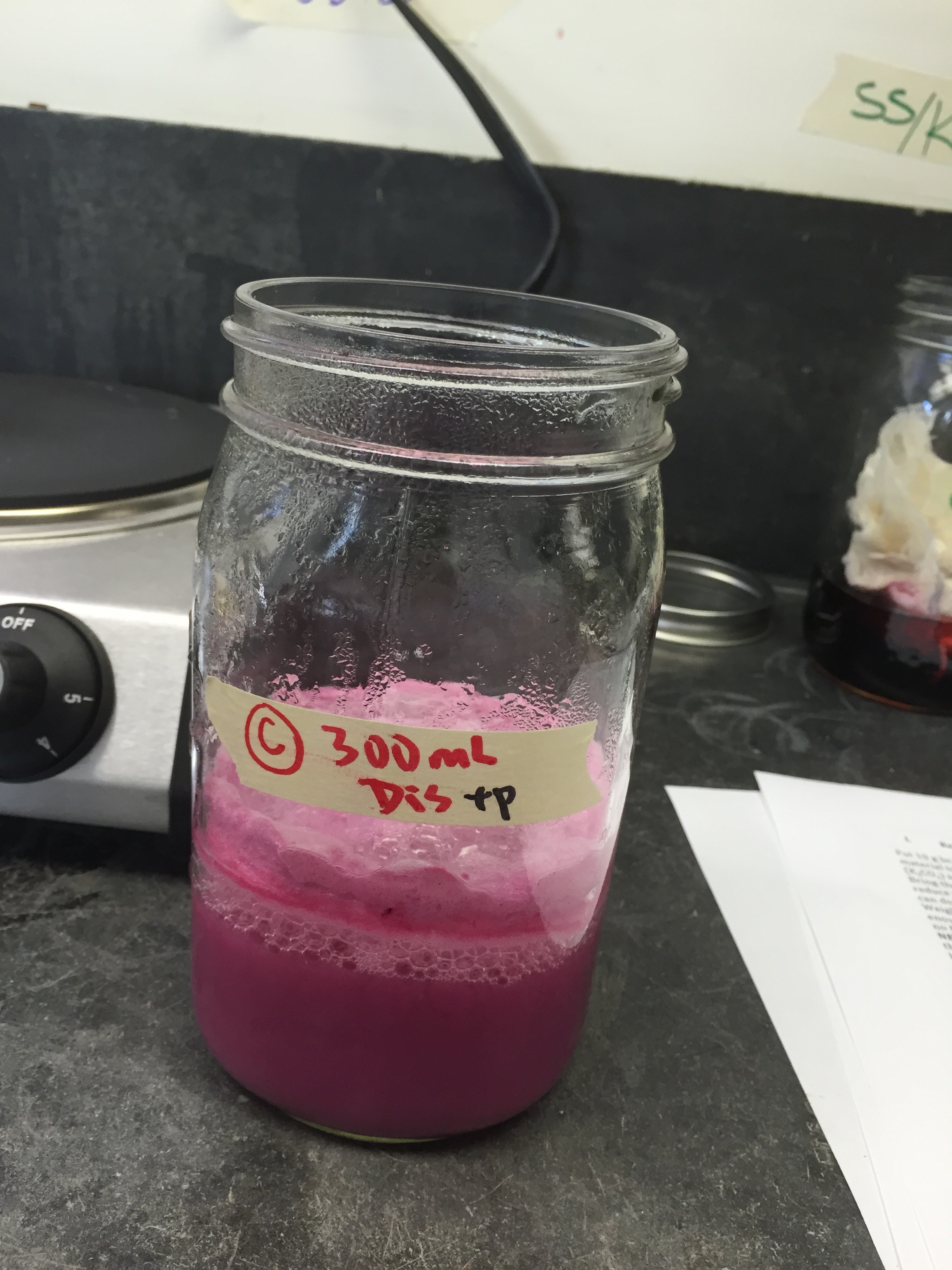
11:41am
Tested pH – was at 4, slightly acidic – decided to retest pH
11:42am
pH is at “6” – this is usable
Cochineal solution smelled like ammonium
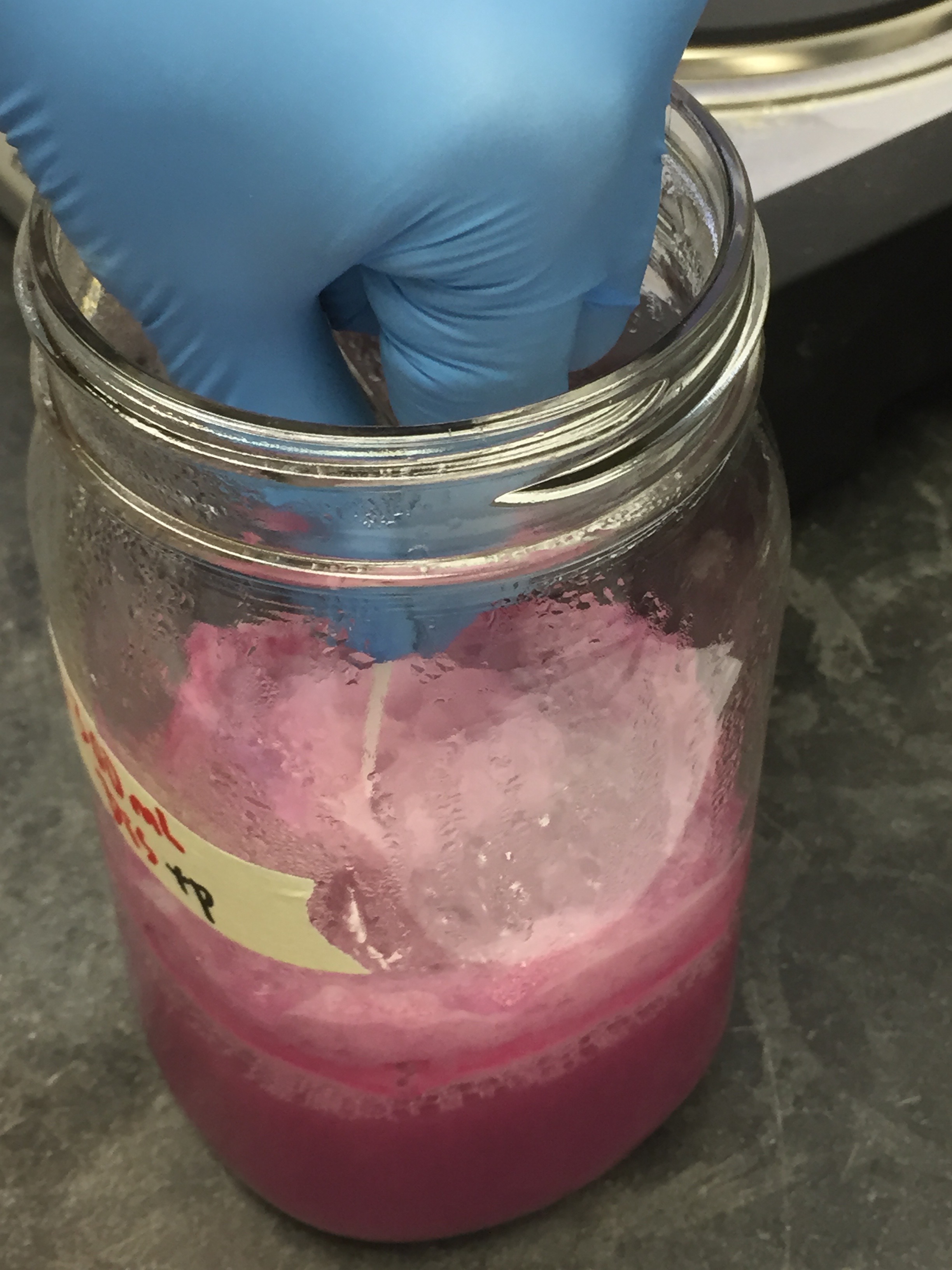
Our cochineal compared to Cindy and Yuan’s cochineal (below)

Cochineal would dissolve in either oil or egg so we are precipitating color onto aluminum in order to retain color
BRAZILWOOD
11:44am
Put brazilwood sachet and solution into a beaker to put on hot plate at 3
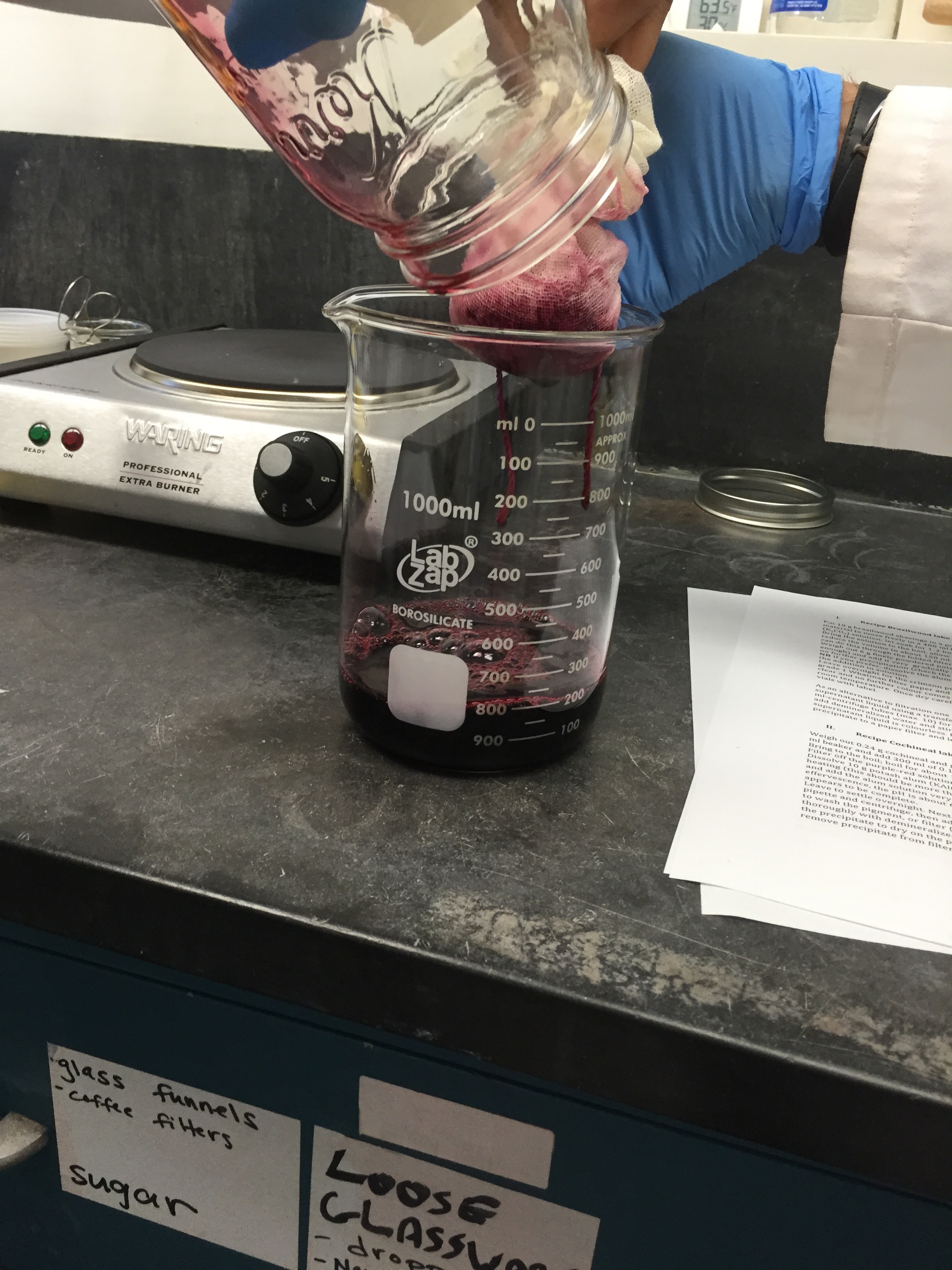
11:50am
Brazilwood solution is 51 degrees Celsius
11:51am
Increased heat to 4
11:53am
Dissolved 6g of potash alum into 50 ml of distilled water to more easily control pouring into brazilwood
11:56am
Brazilwood solution slight boiling
Smelled more pleasant that cochineal – more like plant
11:59am
Reduced temperature to 2
12:00pm
Reduced temperature to 1
12:01pm
Solution is at 150ml
Removing sachet and squeezing out solution
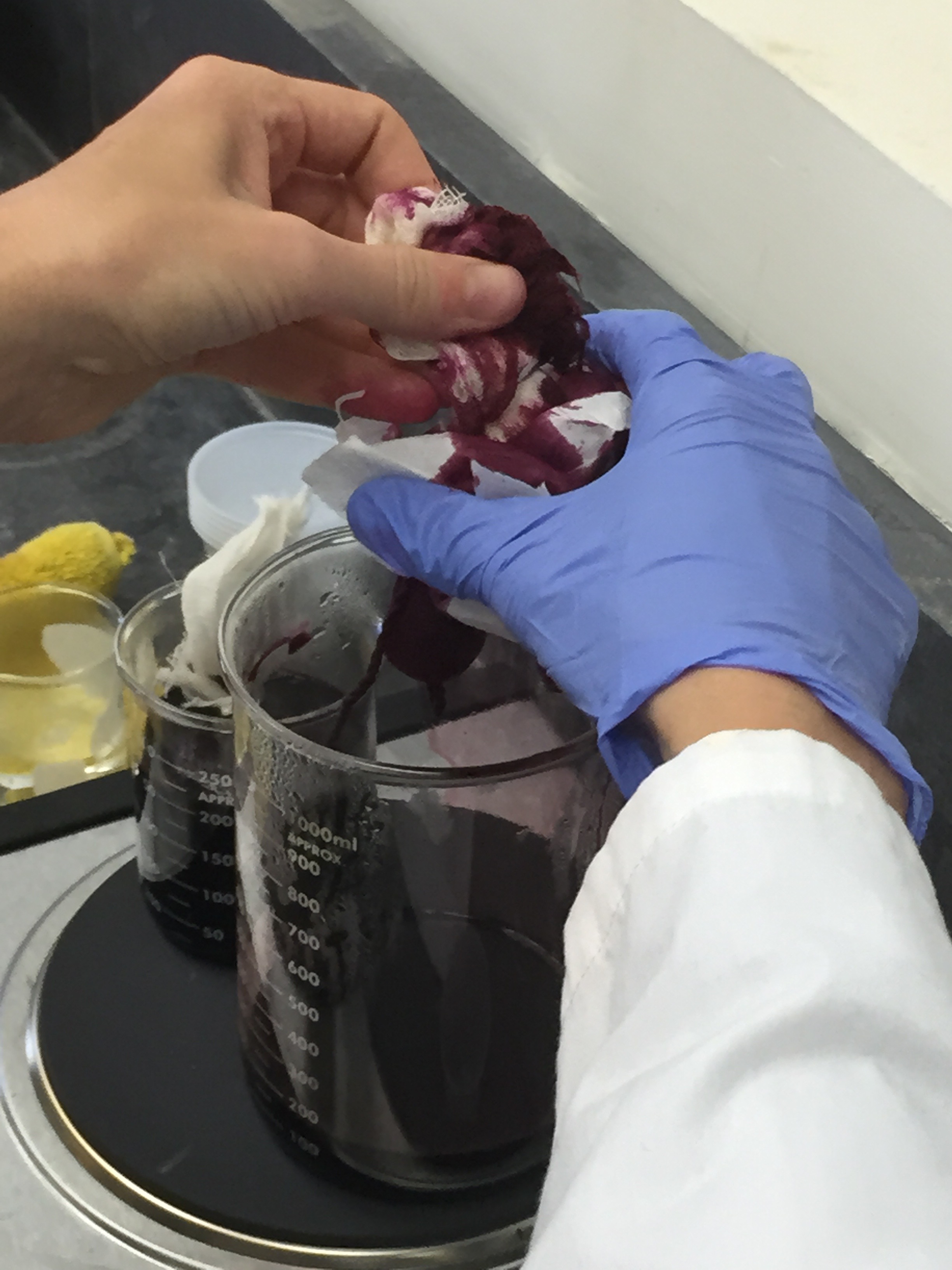
12:04pm
Poured solution through filter/funnel into jar

12:05pm
Stirring solution while pouring in potash solution; achieved effervescing; shook solution to get scum off edge
Color is very red, not “beet red”
Foam seems to be more solid than cochineal solution’s foam
FILTERING
Cochineal with distilled water
Normally leave cochineal to settle but Glasgow told us that the brazilwood doesn't really settle out very much so we might as well pour it (slowly) through filter, leave it filtering over night. Probably the case with the logwood too. What difference does filtering today and letting it sit overnight versus letting it sit overnight and filtering do? (PS)
Leave brazilwood solution from earlier to settle
1:18pm
Filter: Poured solution of cochineal and distilled water + potash into jar through filter and funnel
At first, quite liquidly, then more viscous and opaque sediment in bright magenta color
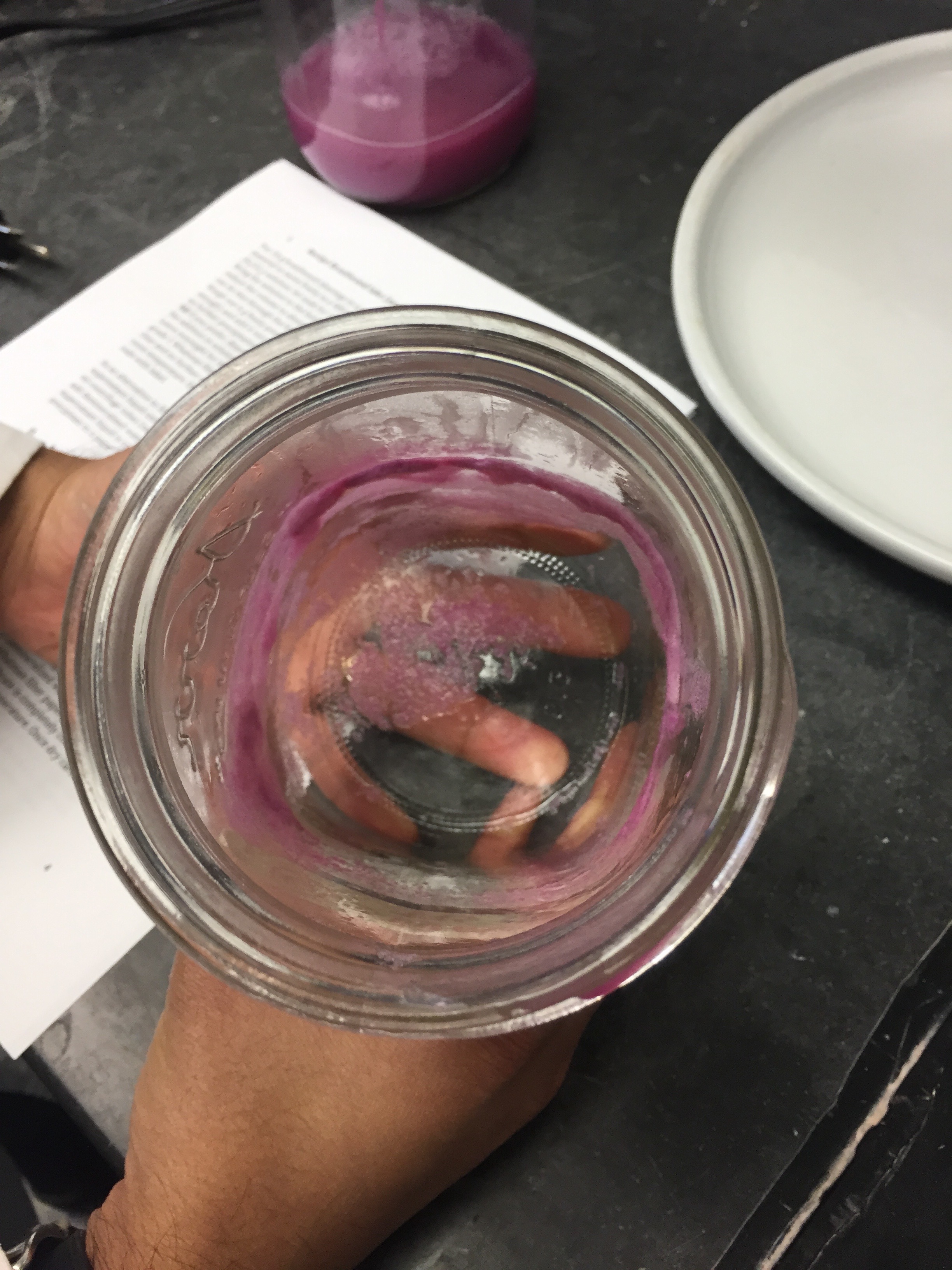
1:24pm
Emptying jar with filtered liquid
Plan to wash pigment as many times as necessary with distilled water until filtering clear
1:26pm
1st wash with 250ml of distilled water
MISTAKENLY washed sediment down the drain sediment
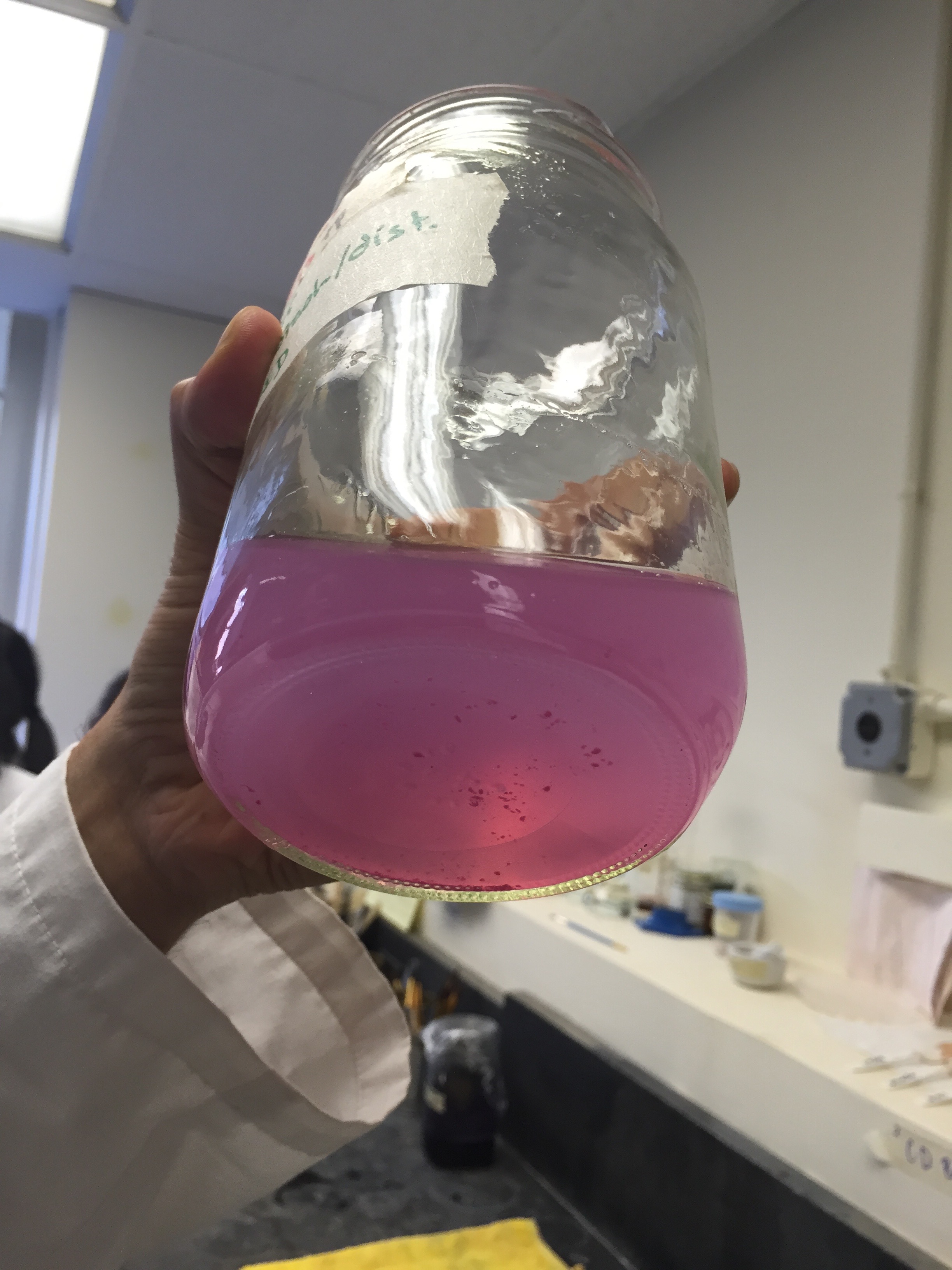
1:27pm
2nd wash with 100 ml of distilled water
Solution was filtering too quickly, prompted us to look for a hole – Siddhartha noticed small tear
1:31PM
Pouring filtered solution through lab grade filter paper in a separate funnel – filtering completely clear. From this, we decide that our pigment is thoroughly washed.
Pouring filtered solution through coffee filter in separate jar as well – lab grade filter is filtering better than coffee filter – liquid is totally clear as opposed to coffee filter jar which is slightly pink but still quite clear
Found that pouring liquid not directly on center, rather down side, may be a more sensitive way to filter re: weight of solution, pressure, etc.
Filtering the twice filtered refuse again through lab grade filter paper – filtering totally clear

BRAZILWOOD + DIST. WATER +POTASH FILTERING:
20.10.2015
Lab
4:35pm
Filter
21.10.2015
Lab
12:30pm
1st wash
1:00pm
2nd wash
1:50pm
3rd wash
2:05pm
4th wash
2:45pm
5th wash
3:30pm
6th wash
22.10.2015
Lab
2:42pm
7th wash
2:58pm
8th wash
(photos mid-wash, did not note at which wash these were taken)